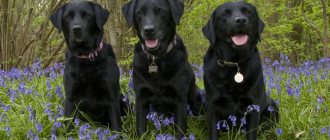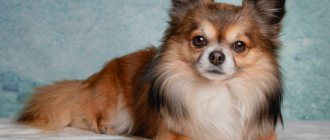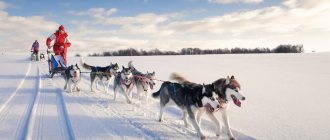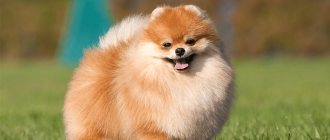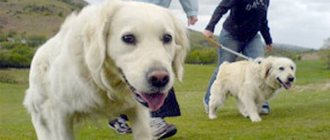| Origin: | England |
| Usage: | watchman, companion |
| Color: | apricot, brindle, fawn |
| Dimensions: | males 76 cm and 68 – 113 kg, females 70 cm and 54 – 91 kg |
| Lifespan: | 6 – 10 years |
A good-natured giant - this is how the mastiff can be briefly described. The ancestors of these loving and devoted dogs hunted lions and bears, participated in gladiator battles and dog fights, supervised slaves and fought against legionnaires. But today the English Mastiff has lost its ferocity. He loves his family, and more than anything else he loves to lie on the couch. The only thing left in the pet from its ancestors is its protective and watchdog qualities. If he feels threatened, he will immediately turn into a fearless defender.
Description of the breed
The English Mastiff, whose standard has been recognized by major canine organizations (FCI, UKF, FCI), is a strong, confident dog. She should be calm, courageous, wary, but without aggression, and treat strangers.
The minimum weight of an English Mastiff for a female is 54 kg, for a male – 68 kg. On average, a dog weighs 90 – 100 kg. At the withers it reaches 70–80 cm.
Frame
The description of the breed presents a strongly built dog with well-developed muscles. The sizes are large, the bones are wide. The dog is longer in length from scruff to tail than in height. The chest is wide, deep, its volume exceeds the height at the withers by 1/3. The dog gives the impression of great strength. Even the photo of an English Mastiff looks impressive.
The tail is sickle-shaped, large, tapering towards the end. When the dog is calm, it keeps the rod lowered, and when moving it raises it up to the back, but not higher.
Head
Square, with jowls and folds on the muzzle. When the pet concentrates, deep wrinkles gather on its forehead, giving it a menacing appearance.
The nose is large and black. The eyes are set wide apart, dark or hazel in color. The ears are dark or black, drooping, thin and soft, with rounded tips. The teeth, especially the fangs, are powerful. A direct or reverse scissor bite – with the lower jaw protruding slightly forward.
Limbs
Straight, set wide apart, parallel to each other. The joints are developed. The paw pads are balled up, arched, with black nails.
Coat and color
The coat is short, dense, and harsh. The undercoat is soft and dense. The English Mastiff dog breed has the following colors:
- apricot (red);
- fawn (deer);
- dark brindle - the so-called black English mastiff.
An accurate idea of the color will be formed after viewing a photo of an English mastiff.
Regardless of color, there should be a black mask on the face, and the ears and nose should be dark.
The breed standard classifies a small white spot on the chest as a fault. Excessively large white spots on the body, the absence of a mask or its asymmetry are disqualifying faults.
Diseases
Photo of an English Mastiff sitting on the grass
Like many other breeds, the Mastiff suffers from several inherited health problems that are worth being aware of.
- Hip dysplasia
- Elbow dysplasia
- Progressive retinal atrophy
- Bone cancer
- Stones in the kidneys
- Allergies
- Damage to the cranial cruciate ligament
- Cystinuria
- Obesity
- Bloating is gastric torsion.
All of the above diseases pose a threat to the life of your pets. Basically, they cannot be treated at home; consultation and assistance from a specialist are required.
Some dogs gain weight after being spayed or neutered, and it is important to keep an eye on your dog's waistline. If your pet begins to gain weight, you need to adjust your daily calorie intake and increase the amount of exercise. Older dogs also tend to gain weight, so it is important that they are fed and exercised accordingly. Obesity shortens your pet's life by several years.
Photo of an English Mastiff with its owner
Dogs are prone to allergies. The allergens themselves are difficult to identify. But reasons may include the following:
- Certain foods
- Airborne pollen
- Dust mites
- Flea and tick bites
- Chemicals found in household cleaning products.
The veterinarian will determine the cause, and you must take measures to limit the animal’s contact with the allergen.
Application and training
English thugs are taken in as companions. But they are also excellent watchmen and security guards. Moreover, they do not need courses in protective guard training: they protect the territory and their owners instinctively. But, if you wish, you can take classes.
The animal's appearance alone will scare off ill-wishers. It’s not for nothing that even owners of six-month-old puppies are asked “do you happen to have a horse?” In addition, dogs are wary of strangers: they stand between the owner and the stranger, and do not leave until they are sure that their person is safe.
OKD will be required. English Mastiff puppies should undergo this test at 6 – 8 months. The breed's characteristics describe the dogs as intelligent, obedient and diligent. Having learned the command, they will carry it out unquestioningly. But the dogs do everything slowly, so you have to be patient.
Data
The largest dog in the world was a Great Dane named Giant George; his stunning data is included in the Guinness Book of Records. The dog's height was as much as 110 centimeters and weighed 111 kilograms. When standing on its hind legs, the length of the dog was 2.2 meters.
When George died (at the age of 7), a dog named Zeus took his title. He was 111 centimeters tall. Weight - 75 kilograms. When standing on its hind legs, its length reached 2.23 meters. He died 5 years later.
The saddest disadvantage of this beautiful breed is that their life expectancy is practically the lowest of all man's friends. On average, Great Danes live only 6.5 years.
The role of the famous hound of the Baskervilles in the 1981 film “The Adventures of Sherlock Holmes” was played by the Great Dane Cyclone.
What the formidable mask hides: character traits
The intimidating appearance and size of English mastiffs scares away novice dog breeders. But inside the formidable dogs hide loving and devoted friends.
Pets are harmless. They adore all family members. Animals are not touchy; they subtly sense people’s moods and understand when they are out of sorts. Dogs do not tolerate cruelty, but they will forgive rudeness if the owner accidentally loses his temper.
But outsiders need to be careful. Mastiffs will not harm family members, but are extremely wary of strangers. You should not go hugging a dog who is calmly walking next to the owner - the pet may perceive this as aggression or a threat to the owner. And she will fiercely defend him and herself.
Relationships with children and animals
A well-mannered mastiff does not show aggression without a reason. The key word is “well-mannered.” The puppy is socialized from the first days of life, otherwise he will become withdrawn, extremely distrustful, and even cruel.
At first, breeders teach them how to interact with people. They pet the puppies as often as possible, talk to them, and carry the babies in their arms.
The owner’s task is to introduce the puppy to possible situations and living beings with which the pet will have to come into contact. He is taught to communicate with other people, dogs and other pets.
But the main thing is that the dog must learn the rules of behavior with children. If an English Mastiff dog gets to know them as a puppy, she will allow the kids to do anything with her - pull the ears, tail, pull back the jowls and even ride on herself.
English Mastiffs are not recommended for families with children under 7 - 12 years of age. Animals will not harm children on purpose. But due to their large dimensions, they can accidentally push, hit or crush a child.
Mastiffs get along well with other dogs, especially dogs of the same breed. Conflicts sometimes arise between male dogs, but they are easy to stop.
It’s more difficult with cats and other pets. Dogs are not cattle dogs; they do not have an innate loyalty to small animals. They get along together if they grew up side by side. But bringing a kitten into a home where there is an adult mastiff is a mistake. Dogs rarely take a new pet calmly and can easily devour the baby.
Who Shouldn't Own Mastiffs
It is worth noting that raising dogs of these breeds, due to their gigantic size, will require some strength to cope with them at the time of disobedience or unwanted behavior. For example, older people, children or people with disabilities may find them difficult to cope with. People who are inexperienced in raising dogs should not own any member of the mastiff family. These animals were originally fighting dogs and are distinguished by a rather willful and independent character, so the owner will need to establish undoubted leadership in order to become the main thing for the dog and achieve respect and unquestioning obedience.
Nuances of maintenance and care
Pets are easy to care for, but expensive to maintain. The dogs are large, they need a lot of space and a huge amount of food. In addition, they are prone to numerous diseases, so you will have to budget a certain amount for veterinary services.
A private home is suitable for mastiffs. You can keep them in an apartment if it is large, with spacious rooms and not crowded with furniture - “fat ones” need space to maneuver.
You can keep a dog in an enclosure only in the warm season. At temperatures below 0°C it freezes. But constant life on a leash is not for him: it is vital for a pet to be part of a family and constantly in contact with people.
Pets are not suitable for squeamish people. They carry a lot of dirt on their paws into the house, drool profusely, snore loudly (like all brachycephalic breeds) and pass gas.
The advantage of mastiffs is silence. They rarely bark. That's why the neighbors are in a multi-story building. They will only hear a loud stomp from above.
Grooming
Easy care. Need to:
- brush the dogs every day with a massage brush - due to the short hair, the procedure will take about 15 minutes;
- brush your teeth weekly;
- once every 7-10 days, examine and clean your eyes and ears;
- Trim the nails every 2 weeks if they do not grind down on the asphalt on their own.
Bathing
Washing is problematic. Pets need to be bathed once a quarter, but every bathing day is a test for the owners.
English Mastiffs do not like to wash themselves. Weight also plays a role: dragging a 100 kg animal into the bath is a problem. In addition, they are difficult to soap and pour water on due to their large growth.
Bathe animals with hypoallergenic shampoo for short-haired dogs. After the bath, make sure that dogs do not lie in drafts.
Paws are washed after every walk. At the end of the meal, wipe the folds on the face from food debris.
Walk
The owners of English mastiffs are not familiar with the situation when the dog runs up to them with a leash in its teeth and asks to go for a walk. The English Mastiff dog breed is famous for being a homebody. Their favorite pastime is lying around in a cozy, warm place. Therefore, the first thing you have to do is buy a bigger sofa.
But dogs need physical activity. Running and playing sports are not suitable for them, but leisurely walking for an hour or two is the best option. It is better to walk your pet over rough terrain to train muscles and strengthen joints.
Prepare a bowl, and a bigger one: feeding features
Nutrition is a stumbling block. Dogs literally eat buckets. The owners joke that it is easier to feed a piglet than a mastiff.
Feeding standards for puppies of different ages are as follows:
- at 1 – 3 months – 5 times a day, 0.5-0.8 l;
- at 4 – 6 months – 3 – 4 times a day, 1-1.5 l;
- at 7 – 8 months – three times a day, 2-2.5 l;
- from 8 months – 2 times a day, 3-5 liters.
Mastiffs themselves do not agree with the standards. They don't mind eating 2-3 times more. Animals will have to be controlled, because... they are prone to obesity.
You can feed your pets with ready-made super-premium or holistic-class dry food or natural food. Owners prefer the second option - it is cheaper.
“Natural” should consist of lean meat, offal, fermented milk products, cereals, and vegetables. 1 – 2 times a week give raw eggs, moslaks (large spongy bones), fruits, treats (cheese, dried meat, crackers). You can't salt food.
Mastiffs are given chicken with caution due to possible allergies. There should be a lot of fermented milk products in the diet. Vitamin complexes and mineral supplements are regularly taken in courses to strengthen the bones and joints.
Health
A pet lives on average 8 – 10 years. But with good care and the absence of congenital pathologies, English mastiffs can live up to 15–17 years.
Dogs have strong immunity. They rarely catch colds and easily resist infections.
Diseases
The English Mastiff dog breed is not very healthy. She has many pathologies caused by heredity and type of constitution:
- dysplasia of the elbow and hip joints;
- numerous eye problems that lead to blindness;
- demodicosis;
- pyoderma;
- epilepsy;
- hormonal disorders;
- diseases of the cardiovascular system;
- arthritis;
- allergies;
- urolithiasis disease;
- cherry eye;
- inversion or inversion of the eyelid;
- pathologies of the respiratory organs.
Vaccinations
Dogs are vaccinated as standard. Up to a year, the puppy needs 4 vaccinations: at 2 months, followed by revaccination after 3 weeks, at six months and at a year. In the future, injections are given annually.
Dogs are vaccinated against:
- rabies;
- plague;
- adenovirus;
- parvovirus enteritis;
- hepatitis A.
Depending on the epidemiological situation in the region, the veterinarian will recommend additional vaccination against other dangerous viruses.
German dog
The Great Dane is a breed of dog belonging to the group of giant dogs. The predecessor of this animal were Molossian dogs, brought from England by the Romans during military campaigns. Ancient relatives of the Great Dane are the Asian fighting dogs.
The ancestors of the Great Dane are considered to be a combination of Bullenbeisers (Old English Danes) with large hunting dogs. The latter, in turn, descended from greyhounds and hounds.
In the second half of the 19th century, purposeful breeding of dogs began to develop in Germany, as a result of which they were given the name “German”.
Mating
The first heat in bitches occurs at six months to a year. But it is too early to breed a dog at such a young age. A female no younger than 2 years old can bear and give birth to healthy offspring.
They bring the dogs together in the dog's territory. Before mating, it is better to feed and walk the animals. There are usually no problems with conception.
Pregnancy lasts 63 – 70 days. The volume of portions is increased, but the bitch is not overfed - excess weight makes childbirth difficult.
English Mastiffs are loving parents. Sometimes too much. They may lick the babies too intensively, or, trying to warm the babies, suffocate them with their bodies. The dog's mother is monitored so that she does not torture the babies with excessive care.
Origin story
Mastiffs are huge molossoid type dogs. Their ancestors participated in gladiatorial battles and fought fearlessly in wars during the reign of Julius Caesar. Dogs of this breed are excellent hunters; with their height and weight, they could overcome a bear and a lion. These dogs were very expensive (just like now). One such dog was equivalent to 20 hounds on a hunt or two armed warriors on the battlefield.
Reviews from historians say that in the army of Alexander the Great there were 50,000 mastiff-like dogs dressed in armor. You might think that this is a ferocious and cruel dog, but this is no longer the case. Centuries-old selection has turned these dogs into calm, balanced, leisurely and kind companions.
Most experts believe that their ancestors were Tibetan mastiffs. During its existence, the breed has undergone many changes. After World War II, this breed, like an incredible number of other breeds, was practically exterminated. To restore the population, they had to be crossed with the American line of the breed.
How to choose a puppy
English Mastiffs are a popular breed. They are bred by everyone who is not too lazy and whose finances allow them to support the “big guys”. Therefore, there is a high risk of running into an unscrupulous person class=”aligncenter” width=”600″ height=”355″[/img]
To buy a healthy purebred puppy you need:
- acquire a friend only in official nurseries;
- check the pedigrees and veterinary passports of the parents, the metrics of the puppies;
- pay attention to the appearance and character of the kitten - it should be moderately well-fed, cheerful, playful, not shy or snappy, eat well, without dark plaque and pus in the ears and eyes.
Puppies are weaned from their mother at 1.5 – 3 months. Babies less than 6 weeks old cannot be sold - they still feed on milk.
How much do puppies cost?
At the poultry market or by advertisement, English mastiff puppies are sold for 6–15 thousand rubles. But these are not purebred cuties.
Breed-class pets with a pedigree cost at least 50,000 rubles, but how much a show-class puppy costs cannot be answered with certainty. Their price exceeds 100 thousand rubles. They sell pet-class treats cheaper - for 25 - 35 thousand rubles.
The best nurseries in Moscow and St. Petersburg
You can buy an English Mastiff in Russia in the following trusted kennels:
- https://www.englishmastiff.ru/englishmastiff/ – “Shulvi Rozan” became the best nursery in Russia three times;
- https://mastiffhills.ru – the breeder breeds mastiffs imported from Germany and England;
- https://www.biboshu.narod.ru/biboland/biboland.htm – breeding dogs and offspring of BiboLAND became prize-winners of major Russian and foreign exhibitions.
On the nurseries' website you can see photos of puppies and parents.
English Mastiffs are a dream for inactive lovers of large dogs. With dogs you don’t need to run outside for half a day or go through endless training courses. To be happy, they need a couple of hours of measured walks, a wider sofa and the love of their owner.
Saint Bernard
Another one of the largest dogs in the world is sometimes considered the St. Bernard. There are two varieties: short-haired and long-haired.
The Saint Bernard comes from the breed described above - the Mastiff of Tibet, which was crossed with the local dogs of Europe.
The name itself comes from the French Chien du Saind-Bernard, which means “Saint Bernard’s dog.”
In the 11th century, a monk named Bernard founded a shelter for lovers of travel. Then not only the pass in the Alps is named after him, but also the shelter itself. Since the building was located in the mountains at an altitude of about 2400 km, natural disasters occurred frequently. To save victims in the 17th century, they decided to use St. Bernards. The thick skin of the dogs not only protected them from snow and ice, but also warmed the survivors. In addition, the animal had an incredible sense of smell, which was able to find victims even under avalanches.




